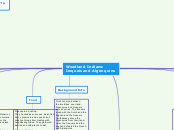Woodland Indians:
Iroquois and Algonquins
Language
Algonquins: Algonquin Language
(Anicināpemowin or Omàmiwininimowin)
(Musical language that has complicated
verbs)
Ex. "Meegwetch" means "thank you"
Iroquois: 6 different languages spoken
(Mohawk, Seneca, Oneida, Onondaga,
Cayuga and Tuscarora)
Important Iroquois men learned Mohawk
because it was the language most commonly
used at the Great Council and at Iroquois
religious festivals.
IROQUOIS PICTURES
http://exhibitions.nysm.nysed.gov/iroquoisvillage/images/figure1longhouselg.gif
https://upload.wikimedia.org/wikipedia/commons/thumb/4/4b/Iroquois_6_Nations_map_c1720.png/297px-Iroquois_6_Nations_map_c1720.png
http://www.think-aboutit.com/wp-content/uploads/2013/04/iroquois-hiawatha-6.jpg
Location
Algonquins: Canada
(Southern Quebec and Eastern Ontario.)
Lived north of Iroquois. Short summers,
long winters. They migrated from the
Atlantic coast. Native North Americans
and native Canadians.
Iroquois: northeastern woodlands area.
New York state --> many Iroquois still
live in NY today or across Canada's border.
They lived on East Coast of the US (from
the Atlantic Ocean to Mississippi River also
including parts of Southern Canada.)
Other Iroquois groups were forced to move
west to Wisconsin or Oklahoma and some of
their relatives still live there today. Resided
near lakes and small rivers (fertile land -->
good for farming)
Food
Algonquins: hunting.
They hunted deer, moose, bear, fish.
Some grew corn and squash but
most got crops from trading with
neighboring tribes. They gathered
berries and wild plants to eat.
Iroquois: farming.
Women and children
did most of the gathering
(corns, beans, squash, roots,
berries, nuts)
while men hunted and fished.
Herbs and maple syrup
were collected for medicine
and flavoring.
Iroquois dishes included cornbread,
soups and stews.
Background Info
Much tension between
the two tribes over land.
Algonquins and Iroquois
were enemies. The Iroquois
sided with the Dutch and the
English and the Iroquois
Confederacy drove the
Algonquins from their land.
Later, the Iroquois and the
English defeated the French
and Algonquins.
1642: Iroquois attacked
Algonquins in the winter
Clothing
Algonquins: women
wore long dresses with
removable sleeves while
men wore breechclothes
(animal fur) and leggings.
Both genders wore moccasins.
Clothing was mostly made out
of mammal, bird and fish skins.
They were tanned through a
smoking process and then
stretched to make softer, more
usable leather. Women made the
clothing for themselves and their
family. They decorated with
feathers, shells, paint and
porcupine-quills.
Iroquois: Women wore
wraparound skirts with short
leggings and sometimes special
beaded tiaras. Men wore also
wore breechclothes with long
leggings.They adopted European
costume like long cloth shirts
with fancy beadwork.
Iroquois made their clothing
from soft deerskin. Both genders
wore moccasins. Women kept
their hair long while men wore
their hair in a mohawk.
Shelter
Algonquins: lived in waginogans
or wigwams (dome-shaped
birchbark house made for a single
family unit.) Wigwams were
temporary so they could move
easily. There was a hole at the top to
let smoke from fires out.
Iroquois: lived in longhouses
(large wood-frame buildings covered
with sheets of elm bark.) They were
up to 100 feet long and housed as
many as 60 people (a clan)
Everyone lived close together
in a village (one village consisted
of about 100 long houses)
Religion
Algonquins: believed that
there was a spiritual world
that interacted constantly
with the physical world.
Believed in a primary spirit
or animating force that
encompassed all existence
and was present in all
living and non-living things.
("Kitchie Manitou" or
the "Great Spirit")
Also believed in an evil
spirit "Windigo"
Iroquois: religion centered
around 'Great Spirit' who
was believed to be their
creator. They communicated
to the Great Spirit by burning
tobacco which carried their
prayers. They believed in an
afterlife, where they would
join the Great Spirit.
